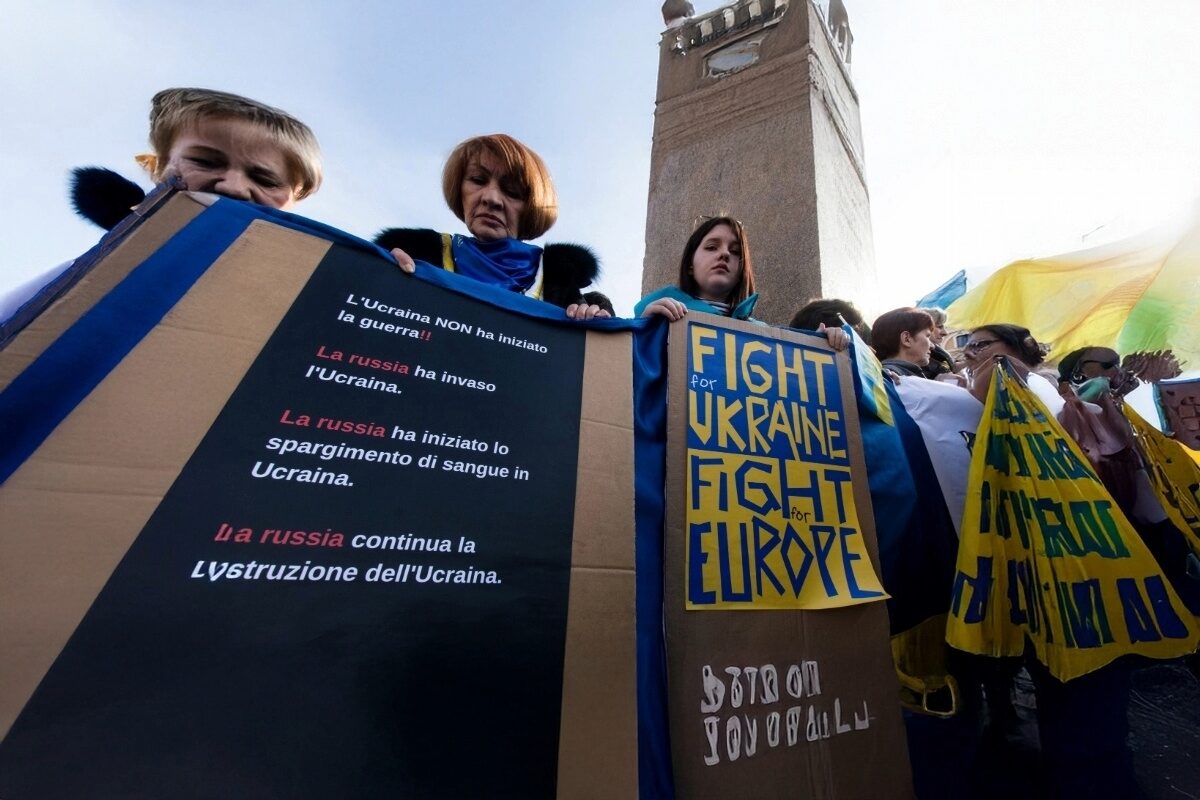Input Paper “European Green Deal for Ukraine: current status and future”

As part of our project “Eastern Partnership Plus”, we are publishing a second series of input papers on the topic of Perspectives and Priorities European Green Deal (EGD) in Ukraine, Georgia and Moldova. The authors from the region (Nataliya Andrusevych, Manana Kochladze, Iuliana Cantaragiu) analyse the role of the European Union in supporting the implementation of the EGD and formulate their political recommendations for decision-makers in Berlin and Brussel – für englische Seite.
By Nataliya Andrusevych, Chair of the Governing Board, Resource and Analysis Center “Society and Environment”
Why is the European Green Deal important for Ukraine?
The European Green Deal (adopted by the EU in 2019) has a major impact on attitudes towards sustainability and green transformation in Ukraine. Climate and environmental issues are increasingly playing a role in the discourse of officials and in the business sector, and are appearing on policy agendas at the highest level.
For Ukraine, there are several important points associated with joining the EGD processes:
- Ukraine becomes a part of the pan-European process of green transformation;
- Ukraine obtains new opportunities for green funding, environmental modernisation, and cooperation on concrete green issues with the EU and its member-states;
- Ukraine receives a new impetus to implement its existing international commitments (EU-Ukraine Association Agreement, Paris Agreement, Convention on Biological Diversity, Energy Community Treaty).
Ukraine has established an extensive legal and policy basis for sustainable development. National Sustainable Development Goals for 2030 have been established by presidential decree. These nationally adapted SDGs are accompanied by a framework for monitoring progress, with annual reports. The State Environmental Policy Strategy and the more recent National Economy Strategy both identify sustainable development as a key goal and principle. There are references to sustainable development in numerous other national sectoral policy documents.
In practice, these and other strategies have had little effect on development trends. This is due to the overall lack of capacity for strategic and policy planning and implementation in Ukraine. In addition, sustainable development is usually perceived as simply “stable” development, i.e. continuous growth. Traditionally, green issues have not been a priority on the political agenda in Ukraine, and the environmental component of sustainable development has received less attention than any other components.
What are the priorities for and forms of cooperation?
Ukraine has expressed its support for the EGD as well as an ambition to align its policies with the EGD goals. Ukraine initiated the bilateral high-level dialog on EGD and promotes cooperation on concrete sectoral issues (such as hydrogen, CBAM, green alliances). Ukraine outlined its vision for future cooperation on the EGD in a position paper presented to the European Commission in the summer of 2020. Several policies and strategies now include references to the EGD.
The recently adopted “National Economy Strategy 2030” introduced the target of transitioning to a climate-neutral economy by 2060. The key targets envisaged by the EU policy documents implementing EGD in most sectors have been fully or at least partially incorporated into Ukraine’s strategic documents (government programmes, action plans, strategies, etc.). However, Ukraine lags behind in many areas: while the EU is improving existing instruments, Ukraine plans to introduce them (for example, emissions trading system, chemicals regulation or waste management).
Several areas are in the focus of policy debate in the context of the EGD, while some other areas are not on the agenda. The top priority areas are energy, climate change, industrial policy in the context of CBAM and energy efficiency. The areas of shared interest within the EGD, as defined at the meeting of the EU-Ukraine Association Council, include energy efficiency, hydrogen, coal regions in transition, industry alliances and climate governance architecture. The zero pollution and biodiversity components of the EGD have not yet been the subject of much debate.
Increasing the energy productivity of its economy lies very much in Ukraine’s interest and the country is facing a need to modernise its production base in all sectors. Thus, there are strong drivers for environmental modernisation, including energy efficiency. The business sector is interested in obtaining state support to help modernise production facilities and is not prepared to cover modernisation costs through private investment alone.
Ukraine has made significant progress in reforming its energy sector since 2014. There is a need for further incentives for reform in other areas: agriculture, transport, environment, climate change, chemicals, industry.
Most of the reforms have been driven by the EU-Ukraine Association Agreement with the help of international technical assistance. For example, Ukraine has made progress in liberalising its energy markets. The share in electricity produced from renewables increased from 6.2% in 2016 to 12.4% in 2020. The EGD may promote these and other reforms and the decarbonisation of the national economy, in particular by greening foreign investment by international financial institutions.
Ukraine has made institutional arrangements specific to the EGD in reaction to the opportunities and threats emerging for Ukraine. In 2020, the Government of Ukraine set up a coordination body specifically to address climate change within the EGD initiative. In 2021, a special working group was established to deal with CBAM and ensure dialogue with the European Commission regarding the draft regulation.
Further liberalisation of energy markets, as well as significant progress in other sectoral reforms, must be coupled with mainstreaming decarbonisation throughout all sectors. All reforms in the EGD-related sectors will require systematic revision of the relevant national legislation, capacity building and investment in infrastructure in order to fully implement EU acquis.
In principle, macro-economic aid and other assistance are conditioned on carrying through key reforms. Implementation the EU-Ukraine Association Agreement is subject to continuous monitoring and the results are publicly available. Macro-economic and technical assistance are usually subject to specific conditions related to specific reforms, such as anti-corruption reforms.
What is the perspective for the future?
All fields encompassed by the EGD are covered by the provisions of the EU-Ukraine Association Agreement, which means that successful implementation of the Association Agreement will enhance Ukraine’s prospects in the EGD context. The upcoming revision (update) of the Association Agreement will strengthen Ukraine’s progress towards the EGD objectives, as well as improve the prospects for a greater involvement of the country in the EGD processes in the EU.
The EGD creates a wide scope for mutually beneficial alignment of Ukraine’s policy and legislation with relevant EU policies and legislation, as well as cooperation between Ukraine and the EU in key areas of the EGD. The EGD communication itself and other implementing policy documents contain specific references to priority cooperation countries, and to Ukraine in particular. For example, the EU Hydrogen Strategy mentions Ukraine as a key partners. Ukraine already participates in a number of green alliances (European Raw Materials Alliance, European Clean Hydrogen Alliance).
The EU has a general new proposal for its Neighbourhood Policy, while Ukraine and other association countries express the need for special “trio” approach, including with regard to to the EGD. It is very important to engage the EaP countries into discussions on the EGD in the EU to build the co-ownership of the process, including by taking into account specific circumstances in each country.
Ukraine is willing to agree on an EGD roadmap with the EU, as are the Balkan countries. The development and implementation of such a roadmap could provide new impetus for a green transformation of Ukraine and support the EU’s own green transition. The EU and Ukraine should launch flagship initiatives – mutually beneficial strategic partnerships or projects on specific issues, including climate governance architecture, energy poverty eradication, climate-oriented agriculture, hydrogen, Ukraine’s participation in green alliances, development of a Natura 2000+ cluster to support biodiversity protection in Europe. The EU and its member-states should support Ukraine’s integration into new green production chains through industrial dialogue, information exchange, support for investments in green innovation and infrastructure. This will promote the integration of Ukraine’s businesses into the new green system of the EU. Separate flagship initiatives could target green cities, green communities, and more generally citizens of Ukraine (e.g. European Climate Pact and New European Bauhaus).
Nataliya Andrusevych,
Chair of the Governing Board, Resource and Analysis Center “Society and Environment”
Gefördert durch:

![]()
Did you like thike this article? If yes, you can support the independent editorial work and journalism of LibMod via a simple donation tool.
We are recognized as a non-profit organization, accordingly donations are tax deductible. For a donation receipt (necessary for an amount over 200 EUR), please send your address data to finanzen@libmod.de
Related topics
Newsletter bestellen
Stay tuned with our regular newsletter about all our relevant subjects.





